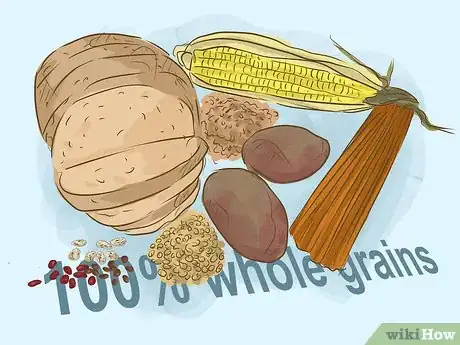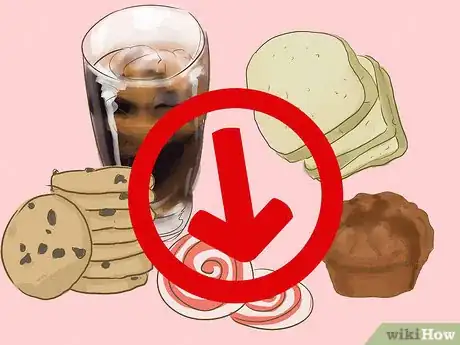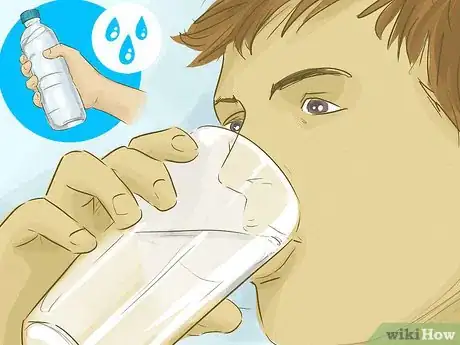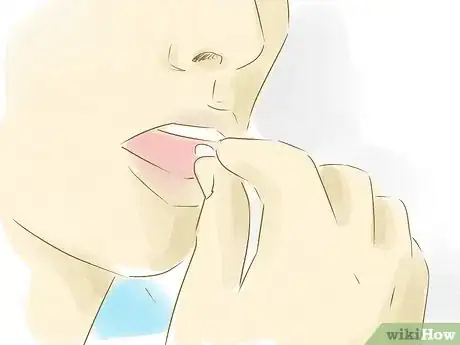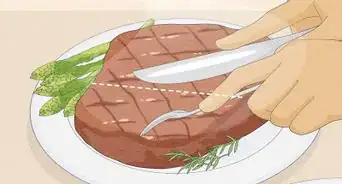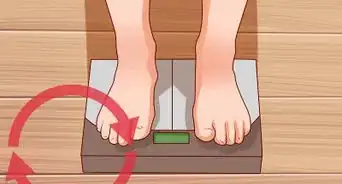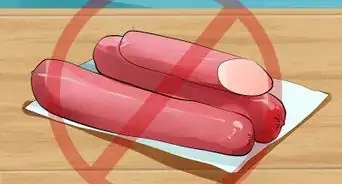This article was co-authored by Tara Coleman. Tara Coleman is a Clinical Nutritionist who has a private practice in San Diego, California. With over 15 years of experience, Tara specializes in sports nutrition, body confidence, and immune system health and offers personalized nutrition, corporate wellness, and online learning courses. She received a BS in Biology from James Madison University and spent six years in the pharmaceutical industry as an analytical chemist before founding her practice. Tara has been featured on NBC, CBS, Fox, ESPN, and Dr. Oz The Good Life as well as in Forbes, Cosmopolitan, Self, and Runner’s World.
There are 19 references cited in this article, which can be found at the bottom of the page.
wikiHow marks an article as reader-approved once it receives enough positive feedback. In this case, 80% of readers who voted found the article helpful, earning it our reader-approved status.
This article has been viewed 425,290 times.
Many people realize that healthy eating habits can help support a healthy weight, manage or improve chronic diseases and maintain overall good health. But a diet that contains more processed, less nutritious foods can lead to weight gain and poor health.[1] If you want to develop healthy eating habits, make small changes over a longer period. You'll need to focus on eating consistent, well-balanced meals and eating a variety of foods. This will help ensure you're consuming enough nutrients to support your body and daily activities. Developing healthy eating habits is a great way to improve your health and can be just a few small changes away.
Steps
Getting Ready to Improve Your Eating Habits
-
1Talk to your doctor. Make an appointment to consult with your doctor before making any lifestyle, exercise or dietary changes. She will be able to tell you what's appropriate and safe for your specific health conditions.
- Explain that you're interested in cleaning up your diet and eating better. Provide some information about why you're making these changes and what you hope to achieve.
- Also ask your doctor if she has any suggestions for you. Many times if you are on certain medications, have a certain health condition or need to lose weight, your doctor may be able to give you a few tips to help you get started.
-
2Talk to a registered dietitian. These health professionals are licensed nutrition experts and can really be a great resource when you're trying to develop healthy eating habits. This area is their specialty.
- Ask your doctor for a referral to a local dietitian or someone she works with. You can also do an online search for a dietitian in your area.
- Talk to your dietitian about your goal for improving your eating habits and what you hope to achieve with better habits.
- Ask him about other changes they think would be helpful to you. He or she may be able to suggest additional changes outside of the ones you've thought of.
Advertisement -
3Start a food journal. Before overhauling your diet and eating habits, it's a good idea to journal about where you currently are with your diet.[2] Journaling is a great place to start because it gives you an insight into where your starting point is. It makes you realize your strengths and makes you aware of your weaknesses. A journal can also help you keep yourself accountable as you develop new, healthy eating habits.
- Keep track of all your food and beverages for at least one week. Try to be as accurate as you can when you're tracking your food. Even a few bites while you prepare meals should be accounted for.
- Don't forget to track how many ounces of clear, hydrating fluids you drink. This is an area that's also an important part of healthy eating.
- After you've kept your journal for a few days, star or highlight areas where you think you could make changes. For example, you might notice you don't drink enough water or typically skip breakfast. These are great areas where you can make healthy changes.
-
4Write yourself a plan. Using your journal and doctor's advice, make a plan for your new healthy eating habits. This "to-do list" will help you set yourself up for success long-term.[3]
- It might be helpful to start by writing a list of all the small changes you'd like to make to your diet and eating patterns.
- Number or list your changes in the order of when you're going to tackle each of them. It's best to just choose one to two changes to make at a time.[4] Trying to overhaul your diet all at once can be difficult and hard to sustain long-term.[5]
- Schedule or write in your calendar which changes you'll be making each week or few weeks. Keep track of how successful or unsuccessful you are after each change.
-
5Buddy up. When you're trying to make lifestyle changes, it can be beneficial to find a friend, family member or another support system to help you. Many people are more successful when they are supported through their changes.[6]
- Talk to your friends, family members or coworkers about your plan for improving your diet. Ask if anyone would like to join you. Together, you may be able to collaborate on different healthy eating ideas, recipes or ideas when the going gets tough.
- You can also sign up for online support groups or forums where others are also trying to improve their eating habits.
Changing How You Eat
-
1Eat regular, scheduled meals each day. Eating a healthy diet is only part of the battle. Eating on a scheduled regimen is equally, if not more, important. You should realize that eating too often or not often enough can cause gaps in your day, lowering metabolism and causing irregular cravings. It's important that we're nourished adequately throughout the day to prevent fatigue, grogginess and to perform at an optimal level.
- It's important to eat regular, consistent meals each day.[7] In general, it's important to eat about every three to four hours. Some people may prefer to have four or five small meals a day, whereas others may stick to three meals daily. This timeline may differ for everyone, but it's still not healthy to skip meals.
- One study showed that when mice ate just one large meal per day and fasted the rest of the day, their insulin resistance and abdominal fat increased.
- Plan for quick or easy-to-prepare meals to make it easier to stay consistent with your eating schedule. Foods like individual yogurts, fruit, nuts, hard-boiled eggs, cheese sticks, or a protein shake are easy to eat on the run and require minimal prep work.
-
2Eat a protein and fiber-rich breakfast. When you're planning to eat more consistently, it's also important to eat the right foods in each of your meals. This is especially true for breakfast. This meal will pave the way for the rest of your day.
- Studies have shown that breakfasts that are high in protein help lead to better hunger management during the day. People felt more satisfied and showed reduced cravings during the day.[8]
- Breakfasts that also contained a high amount of fiber have been shown to be beneficial as well. Fiber adds bulk to meals and takes longer to digest compared to low fiber foods. This helps increase satisfaction and manage hunger throughout the day.
- Examples of high protein, high fiber breakfasts include a small whole wheat tortilla with scrambled eggs and cheese, cottage cheese topped with fruit, whole grain oats topped with dried fruit and nuts or a breakfast smoothie made with Greek yogurt and fruit.
-
3Choose healthy snacks. Many people think snacking will lead to weight gain. However, smartly planned snacks between meals can help curb your appetite and provide a little energy throughout the day.[9]
- Do not let yourself become so hungry you overeat at mealtime. If your next meal is more than one hour away, having a snack may help curb your appetite and prevent you from overeating.[10]
- Another appropriate time to snack would be before or after a workout. Snacks can help provide your body with the energy it needs for a good workout or help your body recover from exercise.
- If you're trying to lose weight, snacks shouldn't be more than 150 calories.[11] Snacks should also only be eaten when you are truly hungry, and it's appropriate to snack.
- Healthy snacks include: 1/4 cup of nuts, whole grain pita chips with hummus, apple with 2 tablespoon (29.6 ml) of peanut butter or a small Greek yogurt.
-
4Take at least 20 minutes to eat your meals. Studies have shown that the slower you eat, the more likely you are to feel satisfied after a meal.[12] Taking at least 20 minutes to eat your meal can help slow you down so you can feel satisfied sooner and with less food. Taking the time to eat mindfully and to enjoy every bite is a great way to prevent overeating and ensure that you're listening to your body.
- Those who ate slower not only felt more satisfied but also consumed less food.[13] This may be due to the fact they realized they were satisfied and didn't eat until they were overly full.
- Try these tricks to help yourself slow down: set a timer for 20 minutes, put your fork down between each bite, drink more water between bites, talk to friends or family while you eat or count how many times you chew each bite.
- Also do not get distracted while eating. Turn off TVs and cell phones while you're eating. Also, try not to read, check emails or do other work while you're eating.[14]
-
5Stop eating when you're satisfied, not full. When you eat until you're too full or overly full, you're most likely consuming too many calories for your body's needs. This is not a healthy habit to continue as it could cause weight gain.[15]
- It may be difficult to tell when you're only "satisfied." It takes about 20 minutes for your brain and stomach to communicate that feeling.[16] That's why it's important to eat slowly.
- In general, satisfaction may feel like: a lack of hunger, disinterest in your food, a very slight stretching sensation or the feeling that you won't need to eat again for a few hours. When you're satisfied, you should leave some food on your plate.
- When you're eating until you're full, you may feel: uncomfortable, bloated, sick, a significant stretching sensation in your stomach. When you're full, you most likely cleared your plate or had additional servings of food.
-
6Instill good eating habits in your kids. If you're trying to improve your eating habits, you may also want to improve the eating habits of your entire family.
- Kids can be a difficult group to get to eat healthy. However, they are quick to learn and imitate behaviors they see in their parents.[17]
- Cooking together with your kids and taking them to the grocery store can help them feel involved, more excited to try new foods and eat healthier.[18]
- Introduce new foods slowly to kids. If you're just starting to eat better at home, your kids might not jump on the bandwagon so quickly. Be patient with them as they adjust their tastes to your new eating pattern.
- Get creative with your meals and snacks. Making foods look fun and interesting can help kids feel more comfortable trying new items.[19] For example: make a smiley face out of cut-up fruit, or make "ants on a log" (celery spread with peanut butter and topped with raisins).
Changing What You Eat
-
1Choose lean protein sources. Lean protein is an essential nutrient in your diet. It provides the basis for the majority of your body's processes and functions. Choosing healthy, lean sources of protein at each meal can help meet your body's needs each day.
- In general, one serving of protein is about 3-4 ounces. This is the size of your palm or a deck of cards.
- Most of your protein choices should be lean. These contain higher amounts of protein and less fat which can help support a healthy weight. Choose items like poultry, eggs, lean beef, seafood, legumes, pork, tofu or low-fat dairy products.
- It's appropriate to eat higher fat protein sources on occasion. However, these types of foods should not be the main source of your protein.
-
2Eat five to nine servings of fruits and vegetables daily. Both fruits and vegetables are low in calories and incredibly nutrient-rich.[20] [21] Eating adequate servings of these foods can help you reach a variety of your nutrient goals each day.
- One serving of fruits is 1/2 cup or one small piece of fruit.[22] One serving of vegetables is one cup or two cups of leafy green vegetables.[23] Make half of your plate a fruit or vegetable to help you meet your daily goals.
- Choose a variety of fruits and vegetables that are deep in color. These contain more nutrients compared to paler vegetables. For example, choose spinach over iceberg lettuce or choose butternut squash over yellow summer squash.
- Also choose a wide variety of fruits and vegetables each day and week. You will limit your nutrition if you only eat one or two types of fruits and vegetables.
-
3Choose whole grains over refined grains.[24] When you're eating foods like bread, rice or pasta, it's beneficial to eat 100% whole grains instead of refined grains.
- Whole grains are less processed and contain the entire grain — bran, endosperm and germ. These foods are typically higher in fiber, protein and other essential nutrients.[25] Choose items like brown rice, quinoa, whole grain oats or 100% whole wheat bread.
- Refined grains are those that are more processed and generally do not contain the nutrient containing parts of the grain. Refined grains are lower in fiber, protein and other nutrients. Items like white bread, plain pasta or white rice are refined grains.
- One serving of grains is about 1 ounce. That could be one slice of bread or about 1/2 cup of pasta or rice. Include three to four servings of these foods each day.
-
4Limit highly processed junk foods. These types of foods generally contain more sugar, fat, sodium and overall calories.[26] To help promote a healthy diet and weight, it's important to reduce the intake of these types of foods.
- Limit foods like candy, cakes, cookies, pastries, frozen meals, processed meats and chips or crackers.
- Try to eat mostly whole, minimally processed foods like raw fruits and vegetables, frozen or canned fruits and vegetables without sauces or seasonings, fresh or frozen protein without added sauces or seasonings, whole grains and low-fat dairy products.
-
5Drink more water. Adequate hydration is an essential component of a healthy eating plan. Adequate hydration helps your body function normally.[27]
- Everyone needs a different amount of hydrating fluids each day. New guidelines suggest this method to find out how many ounces to drink each day: divide your weight in half, and that will give you the number of ounces of fluids you should consume.[28] If you weigh 150 lbs. you should drink 75 oz or a little over nine cups. Try to drink this much as your initial goal. You may change this amount as you continue to work on your diet.
- Choose fluids that are sugar-free and decaffeinated as they hydrate you the best. Items like water, flavored water, decaf coffee and tea are appropriate types of beverages.[29]
- Reduce or cut out sweetened beverages. The consumption of sweetened beverages may lead to weight gain. Cut out sodas, juices, sweet teas and alcohol.
-
6Considering taking supplements. Vitamin and mineral supplements may help you maintain your healthy eating pattern. These supplements can add extra nutrition to your diet. This may be particularly useful for people with food allergies, diet restrictions or are picky eaters.[30]
- Consider taking a multivitamin. This is a general supplement that contains a wide variety of vitamins and minerals. These are an excellent, all-purpose type of supplement.
- Consider an additional iron supplement. Some people, especially females who are menstruating, may need additional iron.
- Vitamin B12 is typically found in animal foods, and those who are vegetarian or vegan may need an additional B12 supplement.[31]
- Vitamin and mineral supplements are not to be relied upon heavily or used in place of real, whole foods. They are meant to be a supplement to a healthy, well-balanced diet.
- Always check with your doctor before starting any vitamin or mineral supplement. Not all supplements are safe and appropriate for everyone.
Food Journal Entry Template
How Do I Evaluate the Nutrient Density of My Food?
Expert Q&A
-
QuestionHow can you promote healthy eating habits in your home?
 Claudia Carberry, RD, MSClaudia Carberry is a Registered Dietitian specializing in kidney transplants and counseling patients for weight loss at the University of Arkansas for Medical Sciences. She is a member of the Arkansas Academy of Nutrition and Dietetics. Claudia received her MS in Nutrition from the University of Tennessee Knoxville in 2010.
Claudia Carberry, RD, MSClaudia Carberry is a Registered Dietitian specializing in kidney transplants and counseling patients for weight loss at the University of Arkansas for Medical Sciences. She is a member of the Arkansas Academy of Nutrition and Dietetics. Claudia received her MS in Nutrition from the University of Tennessee Knoxville in 2010.
Master's Degree, Nutrition, University of Tennessee Knoxville Master's Degree, Nutrition, University of Tennessee KnoxvilleExpert AnswerTo promote healthy eating habits in your home, buy only healthy foods. Also, cooking at home is a healthy alternative to eating out. Try to focus on eating more vegetables, fruit, and low-fat dairy products. Limit carbs to 1/2 cup portions and meat to 3-ounce servings
Master's Degree, Nutrition, University of Tennessee KnoxvilleExpert AnswerTo promote healthy eating habits in your home, buy only healthy foods. Also, cooking at home is a healthy alternative to eating out. Try to focus on eating more vegetables, fruit, and low-fat dairy products. Limit carbs to 1/2 cup portions and meat to 3-ounce servings -
QuestionHow can you improve your eating habits?
 Claudia Carberry, RD, MSClaudia Carberry is a Registered Dietitian specializing in kidney transplants and counseling patients for weight loss at the University of Arkansas for Medical Sciences. She is a member of the Arkansas Academy of Nutrition and Dietetics. Claudia received her MS in Nutrition from the University of Tennessee Knoxville in 2010.
Claudia Carberry, RD, MSClaudia Carberry is a Registered Dietitian specializing in kidney transplants and counseling patients for weight loss at the University of Arkansas for Medical Sciences. She is a member of the Arkansas Academy of Nutrition and Dietetics. Claudia received her MS in Nutrition from the University of Tennessee Knoxville in 2010.
Master's Degree, Nutrition, University of Tennessee Knoxville Master's Degree, Nutrition, University of Tennessee KnoxvilleExpert AnswerMeet with a Registered Dietitian to get started. Keeping a food journal will help you identify what you need to work on.
Master's Degree, Nutrition, University of Tennessee KnoxvilleExpert AnswerMeet with a Registered Dietitian to get started. Keeping a food journal will help you identify what you need to work on. -
QuestionHow do I change my eating habits?
 Claudia Carberry, RD, MSClaudia Carberry is a Registered Dietitian specializing in kidney transplants and counseling patients for weight loss at the University of Arkansas for Medical Sciences. She is a member of the Arkansas Academy of Nutrition and Dietetics. Claudia received her MS in Nutrition from the University of Tennessee Knoxville in 2010.
Claudia Carberry, RD, MSClaudia Carberry is a Registered Dietitian specializing in kidney transplants and counseling patients for weight loss at the University of Arkansas for Medical Sciences. She is a member of the Arkansas Academy of Nutrition and Dietetics. Claudia received her MS in Nutrition from the University of Tennessee Knoxville in 2010.
Master's Degree, Nutrition, University of Tennessee Knoxville Master's Degree, Nutrition, University of Tennessee KnoxvilleExpert AnswerBuddy up with a friend to make small changes to your diet. Over time, it will become easier to eat healthily.
Master's Degree, Nutrition, University of Tennessee KnoxvilleExpert AnswerBuddy up with a friend to make small changes to your diet. Over time, it will become easier to eat healthily.
References
- ↑ https://www.nhs.uk/live-well/eat-well/
- ↑ Tara Coleman. Clinical Nutritionist. Expert Interview. 22 October 2020.
- ↑ http://www.mayoclinic.org/healthy-lifestyle/nutrition-and-healthy-eating/in-depth/menu-planning/art-20048199
- ↑ Tara Coleman. Clinical Nutritionist. Expert Interview. 22 October 2020.
- ↑ http://www.clinicaladvisor.com/the-waiting-room/small-steps-provide-big-weight-loss-benefits-for-patients/article/393578/
- ↑ http://www.mayoclinic.org/healthy-lifestyle/stress-management/in-depth/support-groups/art-20044655
- ↑ http://aje.oxfordjournals.org/content/158/1/85.full
- ↑ https://www.theatlantic.com/health/archive/2013/03/study-eat-protein-in-the-morning/274417/
- ↑ http://www.mayoclinic.org/healthy-lifestyle/weight-loss/in-depth/healthy-diet/art-20046267
- ↑ Tara Coleman. Clinical Nutritionist. Expert Interview. 22 October 2020.
- ↑ http://www.mayoclinic.org/healthy-lifestyle/weight-loss/in-depth/healthy-diet/art-20046267
- ↑ http://www.health.harvard.edu/blog/why-eating-slowly-may-help-you-feel-full-faster-20101019605
- ↑ http://www.health.harvard.edu/blog/why-eating-slowly-may-help-you-feel-full-faster-20101019605
- ↑ http://www.health.harvard.edu/blog/distracted-eating-may-add-to-weight-gain-201303296037
- ↑ http://health.usnews.com/health-news/blogs/eat-run/2012/08/08/stuffed-or-satisfied-when-to-stop-eating
- ↑ http://health.usnews.com/health-news/blogs/eat-run/2012/08/08/stuffed-or-satisfied-when-to-stop-eating
- ↑ http://www.parents.com/kids/nutrition/healthy-eating/get-your-kids-to-eat-better/
- ↑ http://www.parents.com/kids/nutrition/healthy-eating/get-your-kids-to-eat-better/
- ↑ http://www.parents.com/kids/nutrition/healthy-eating/get-your-kids-to-eat-better/
- ↑ https://www.choosemyplate.gov/eathealthy/vegetables
- ↑ http://www.choosemyplate.gov/fruits
- ↑ http://www.choosemyplate.gov/fruits
- ↑ https://www.choosemyplate.gov/eathealthy/vegetables
- ↑ Tara Coleman. Clinical Nutritionist. Expert Interview. 22 October 2020.
- ↑ http://www.choosemyplate.gov/grains
- ↑ http://www.nhs.uk/livewell/goodfood/pages/what-are-processed-foods.aspx
- ↑ http://www.heart.org/HEARTORG/GettingHealthy/PhysicalActivity/FitnessBasics/Staying-Hydrated---Staying-Healthy_UCM_441180_Article.jsp
- ↑ http://www.pbs.org/americaswalking/fuel/fueldrinking.html
- ↑ http://www.heart.org/HEARTORG/GettingHealthy/PhysicalActivity/FitnessBasics/Staying-Hydrated---Staying-Healthy_UCM_441180_Article.jsp
- ↑ http://www.mayoclinic.org/healthy-lifestyle/nutrition-and-healthy-eating/in-depth/supplements/art-20044894?pg=1
- ↑ http://www.mayoclinic.org/healthy-lifestyle/nutrition-and-healthy-eating/in-depth/supplements/art-20044894?pg=1
About This Article
To develop healthy eating habits, start by eating regular, scheduled meals each day to keep your energy levels up. Try to take at least 20 minutes to eat each meal so that you feel satisfied sooner, which can prevent overeating. Also, plan quick, easy-to-prepare meals and have healthy snacks on hand to keep your diet on track. Finally, remember to stay hydrated throughout the day and consider taking supplements to help you maintain your healthy eating patterns! For tips on specific foods you can incorporate into your healthy diet, read on!





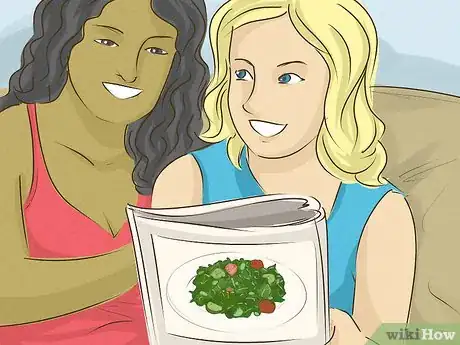


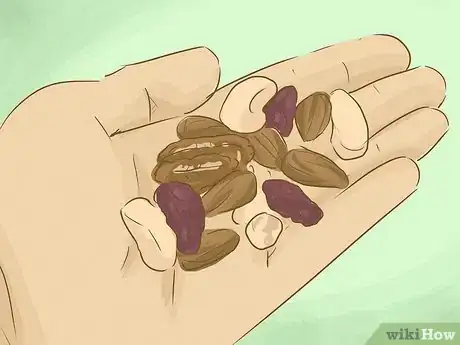
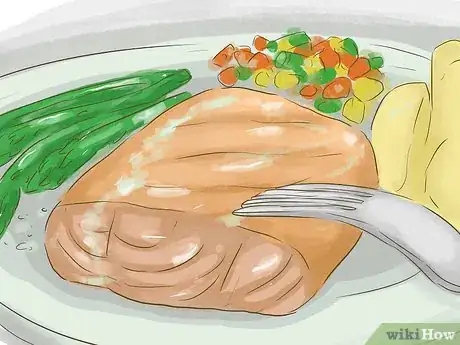

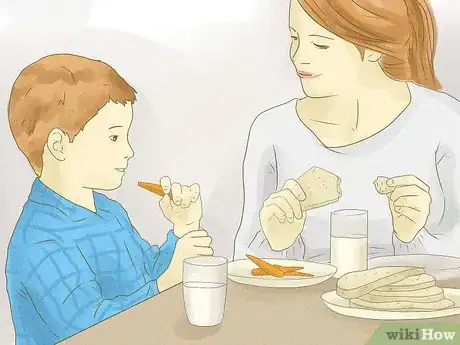
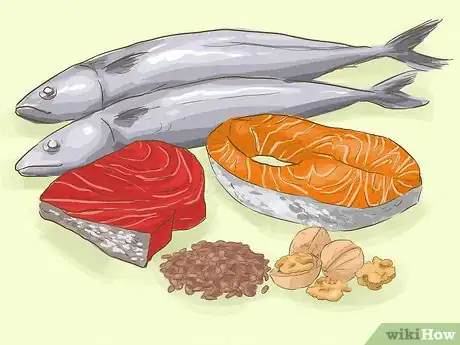
-Step-8-Version-3.webp)
